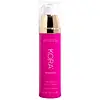What's inside
What's inside
 Key Ingredients
Key Ingredients

 Benefits
Benefits

 Concerns
Concerns

No concerns
 Ingredients Side-by-side
Ingredients Side-by-side

Aloe Barbadensis Leaf Juice
Skin ConditioningAscorbyl Glucoside
AntioxidantGlycerin
HumectantWater
Skin ConditioningLactobacillus Ferment
Skin ConditioningLactobacillus/Acerola Cherry Ferment
Skin ProtectingPotassium Hydroxide
BufferingDicaprylyl Carbonate
EmollientCapsicum Annuum Fruit Extract
AntimicrobialLactobacillus
Skin ConditioningCitrus Limon Peel Extract
EmollientCocos Nucifera Fruit Extract
EmollientTerminalia Ferdinandiana Fruit Extract
AntioxidantMorinda Citrifolia Fruit Extract
Skin ConditioningHydrolyzed Sodium Hyaluronate
Skin ConditioningOlea Europaea Leaf Extract
PerfumingZinc PCA
HumectantLysolecithin
EmulsifyingSclerotium Gum
Emulsion StabilisingXanthan Gum
EmulsifyingPullulan
Caprylic/Capric Triglyceride
MaskingAscorbic Acid
AntioxidantLeuconostoc/Radish Root Ferment Filtrate
AntimicrobialSalvia Sclarea Extract
AntiseborrhoeicCitrus Aurantium Dulcis Peel Extract
Emulsion StabilisingPotassium Sorbate
PreservativeSodium Phytate
Sodium Benzoate
MaskingCitric Acid
BufferingSodium Salicylate
PreservativeEuterpe Oleracea Juice
Skin ConditioningTocopherol
AntioxidantSilica
AbrasiveMaltodextrin
AbsorbentAlcohol
AntimicrobialGlycine Soja Oil
EmollientQuartz
AbrasiveCitral
PerfumingLimonene
PerfumingLinalool
PerfumingAloe Barbadensis Leaf Juice, Ascorbyl Glucoside, Glycerin, Water, Lactobacillus Ferment, Lactobacillus/Acerola Cherry Ferment, Potassium Hydroxide, Dicaprylyl Carbonate, Capsicum Annuum Fruit Extract, Lactobacillus, Citrus Limon Peel Extract, Cocos Nucifera Fruit Extract, Terminalia Ferdinandiana Fruit Extract, Morinda Citrifolia Fruit Extract, Hydrolyzed Sodium Hyaluronate, Olea Europaea Leaf Extract, Zinc PCA, Lysolecithin, Sclerotium Gum, Xanthan Gum, Pullulan, Caprylic/Capric Triglyceride, Ascorbic Acid, Leuconostoc/Radish Root Ferment Filtrate, Salvia Sclarea Extract, Citrus Aurantium Dulcis Peel Extract, Potassium Sorbate, Sodium Phytate, Sodium Benzoate, Citric Acid, Sodium Salicylate, Euterpe Oleracea Juice, Tocopherol, Silica, Maltodextrin, Alcohol, Glycine Soja Oil, Quartz, Citral, Limonene, Linalool
Centella Asiatica Leaf Water
Skin Conditioning3-O-Ethyl Ascorbic Acid
Skin ConditioningEthoxydiglycol
HumectantDimethyl Isosorbide
SolventGluconolactone
Skin ConditioningGlycerin
HumectantSodium Gluconate
Skin ConditioningAcetyl Glucosamine
Skin ConditioningSodium Hyaluronate
HumectantPullulan
Hydroxyethylcellulose
Emulsion StabilisingXanthan Gum
EmulsifyingSclerotium Gum
Emulsion StabilisingPhenoxyethanol
PreservativeEthylhexylglycerin
Skin ConditioningLecithin
EmollientLactic Acid
BufferingCitric Acid
BufferingCentella Asiatica Leaf Water, 3-O-Ethyl Ascorbic Acid, Ethoxydiglycol, Dimethyl Isosorbide, Gluconolactone, Glycerin, Sodium Gluconate, Acetyl Glucosamine, Sodium Hyaluronate, Pullulan, Hydroxyethylcellulose, Xanthan Gum, Sclerotium Gum, Phenoxyethanol, Ethylhexylglycerin, Lecithin, Lactic Acid, Citric Acid
 Reviews
Reviews

Ingredients Explained
These ingredients are found in both products.
Ingredients higher up in an ingredient list are typically present in a larger amount.
Citric Acid is an alpha hydroxy acid (AHA) naturally found in citrus fruits like oranges, lemons, and limes.
Like other AHAs, citric acid can exfoliate skin by breaking down the bonds that hold dead skin cells together. This helps reveal smoother and brighter skin underneath.
However, this exfoliating effect only happens at high concentrations (20%) which can be hard to find in cosmetic products.
Due to this, citric acid is usually included in small amounts as a pH adjuster. This helps keep products slightly more acidic and compatible with skin's natural pH.
In skincare formulas, citric acid can:
While it can provide some skin benefits, research shows lactic acid and glycolic acid are generally more effective and less irritating exfoliants.
Most citric acid used in skincare today is made by fermenting sugars (usually from molasses). This synthetic version is identical to the natural citrus form but easier to stabilize and use in formulations.
Read more about some other popular AHA's here:
Learn more about Citric AcidGlycerin is already naturally found in your skin. It helps moisturize and protect your skin.
A study from 2016 found glycerin to be more effective as a humectant than AHAs and hyaluronic acid.
As a humectant, it helps the skin stay hydrated by pulling moisture to your skin. The low molecular weight of glycerin allows it to pull moisture into the deeper layers of your skin.
Hydrated skin improves your skin barrier; Your skin barrier helps protect against irritants and bacteria.
Glycerin has also been found to have antimicrobial and antiviral properties. Due to these properties, glycerin is often used in wound and burn treatments.
In cosmetics, glycerin is usually derived from plants such as soybean or palm. However, it can also be sourced from animals, such as tallow or animal fat.
This ingredient is organic, colorless, odorless, and non-toxic.
Glycerin is the name for this ingredient in American English. British English uses Glycerol/Glycerine.
Learn more about GlycerinPullulan is a low viscosity polysaccharide (a long chain carbohydrate) with binding and film forming properties when dissolved in water. It is used to create a "silicone-like" or silky feel in cosmetics without adding viscosity.
According to a manufacturer, this ingredient's ability to easily dissolves makes it a great carrier for active ingredients.
Due to it being edible and tasteless, you'll likely find this ingredient in breath freshener strips. This ingredient is produced from the starch of the fungus, Aureobasidium pullulans.
Pullulan is stable over a broad-range of pH.
Learn more about PullulanSclerotium Gum is a polysaccharide gum made by the fungus, Sclerotium rolfssii. It is similar to xanthan gum.
In cosmetics, Sclerotium Gum is used to thicken the texture and to help stabilize other ingredients.
As an emulsifier, Sclerotium Gum helps prevent ingredients from separating, such as water and oil.
Learn more about Sclerotium GumXanthan gum is used as a stabilizer and thickener within cosmetic products. It helps give products a sticky, thick feeling - preventing them from being too runny.
On the technical side of things, xanthan gum is a polysaccharide - a combination consisting of multiple sugar molecules bonded together.
Xanthan gum is a pretty common and great ingredient. It is a natural, non-toxic, non-irritating ingredient that is also commonly used in food products.
Learn more about Xanthan Gum